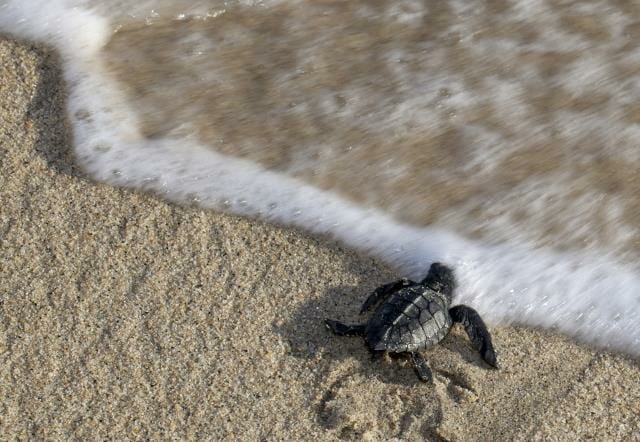
Sea Turtle Nesting Season
Sea Turtle Nesting Season
 Along the North Carolina coast we take the care of our local sea turtles very seriously. Volunteers from all over the coast come in to support the NC Sea Turtle Project, which was created to monitor sea turtle activity along the entire coast of North Carolina. The volunteers consist of all ages, children to adults, and some locals consider their home on the North Carolina coast to be one of the best places to retire because of how involved they can be in the protection of these beautiful animals.
Along the North Carolina coast we take the care of our local sea turtles very seriously. Volunteers from all over the coast come in to support the NC Sea Turtle Project, which was created to monitor sea turtle activity along the entire coast of North Carolina. The volunteers consist of all ages, children to adults, and some locals consider their home on the North Carolina coast to be one of the best places to retire because of how involved they can be in the protection of these beautiful animals.
The start of sea turtle nesting season in North Carolina begins around the first of May. The female sea turtles climb onto the beaches in search of the perfect spot to build her nest, or clutch. Each of these nests consists of about 120 eggs all about the size of a golf ball. Before the sea turtle lays her eggs she must dig out a hole that is about 2 feet below the surface. Once the mother is satisfied with her dug out chamber she deposits all of her eggs and covers them completely in sand to help camouflage them before she goes back into the ocean. Depending on the age of the female, she can have anywhere from 4 to 7 nests per season. Once the water temperatures begin to drop around August, the nesting season is over and the female turtles move in search of food and a place to survive until their next nesting season. Most female sea turtles nest every 2 or 3 years. Once placed the eggs usually take up to 60 days to incubate, but if they are nested in the shade they may take up to 100 days before they are ready to hatch.
On the North Carolina shore we have three main species of sea turtles that come to shore during nesting season. The most common sea turtles being the loggerheads, as well as green turtles, and leatherbacks.
 During the nesting season the sea turtles need all the help they can to keep their eggs safe. All participants and volunteers help greatly by monitoring the coastline every morning for any chance of turtle tracks. Once the tracks are found and the nest is verified to be holding eggs the clutch is covered back up with sand. Stakes and flagging, as well as an official sign are put in to protect the area from being walked upon. After these nesting sites are identified participants come by daily to check their well being, and see if there have been any signs of disturbance, or to see if there are any hints that the eggs are getting ready to hatch, usually the only hint being a tiny depression in the sand.
During the nesting season the sea turtles need all the help they can to keep their eggs safe. All participants and volunteers help greatly by monitoring the coastline every morning for any chance of turtle tracks. Once the tracks are found and the nest is verified to be holding eggs the clutch is covered back up with sand. Stakes and flagging, as well as an official sign are put in to protect the area from being walked upon. After these nesting sites are identified participants come by daily to check their well being, and see if there have been any signs of disturbance, or to see if there are any hints that the eggs are getting ready to hatch, usually the only hint being a tiny depression in the sand.
After a long season of monitoring the nests, and a clear sign that the eggs are going to hatch soon, volunteers sometimes build barriers to help the hatchlings safely find their way to the ocean. The young turtles take a few days to make it to the top of their nest, working together to dig their way out onto the beach to scramble out to the shore. This event is called a boil and it usually takes place during the middle of the night. Around this time volunteers and participants like to bring together a vigil to stay by the nest and watch this incredible experience. With the support of all their human fans the tiny turtles try to make their way across the beach and into the water, occasionally needing the assistance of a volunteer to keep it headed in the right direction. The assistance of all participants and volunteers is greatly appreciated, and is of incredible importance to keep these endangered animals from being swept away from our oceans forever.
Receive your complimentary Relocation guide and magazine


